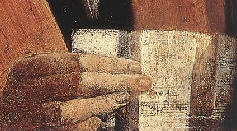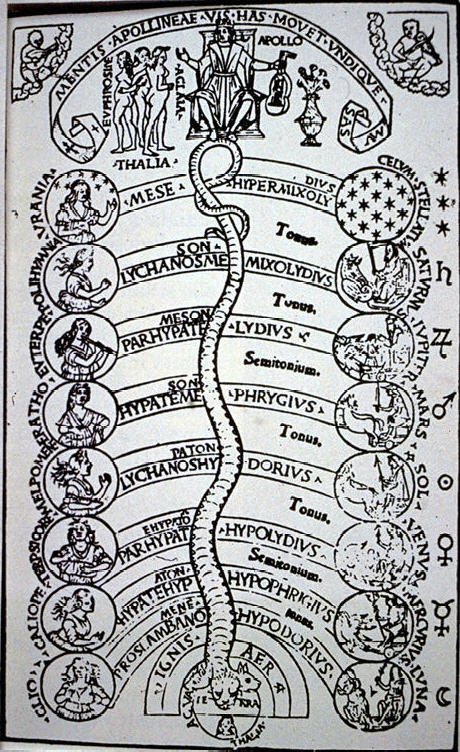The famous painting at the side is said to present Franchino Gaffurio and is ascribed to Leonardo da Vinci.
Works:
- Musicae utriusque cantus practicae ,
- Theorica musicae (1492, reedited from 1480),
- Practica musicae (1496),
- De harmonia musicorum instrumentorum opus (1500).
The following picture (below) is the reason, why we see Franchino Gaffori involved in our studies to the Lazzarelli text. It is dated at an internet page with "1469" as the "frontespizio of Franchino Gaffurio, De praticae musicae", but a comparition with the life dates of Gaffurio shows, that here is a simple writing error and "1496" is the correct dating. So, as in first surprize assumed, not Gaffurio with his representation could have influenced Lazzarelli (who's latest publishing date is 1482), but the logical (momentary) research situation sees either Lazzarelli influencing Gaffurio or both reflecting a general farspread relation between planetaric spheres and Muses.
Gaffurio (* 1451) and Lazzarelli (* 1450) are of the same age, as the current research situation doesn't allow clear insight in the stations of Lazzarelli's life, a relation and personal friendship to Gaffurio cannot be excluded, so the influence between both might have been a very personal one. Lazzarelli was not only poet and later "magician", but also musician with public representations, as reported from 1469 in Padua (unclear source). A meeting of Gaffurio and Lazzarelli in the late 70ies should have been likely, when they had a time in the same city.
Perhaps the successes of both young men (Lazzarelli in the Roman Pomponean Accademia in the early 80ies and Gaffurio 1484) at the same or a similar time touch each other.
Also Leonardo da Vinci is of similar age (* 1452), who in 1484 was already at the Sforza court since 1480, but was not already the famous and well paid artist as he became later. He at least has direct relationships to Gaffurio and should have known also Niccolo da Correggio, who had a familiary relationship to the Sforzas - both, Leonardo and Niccolo, engaged in theatre questions and one of the major activities of Leonardo at the Sforza court was the creation of technical constructions for the famous shows at the Sforza courts in the 90ies. Niccolo is of interest in the questions around Ludovico Lazzarelli.

"It was not until 1904 that the hand and sheet of music were discovered underneath overpaintings, and it is these that have given the painting its present title. Since this discovery, efforts have also been made to identify the person depicted. The names of two important court musicians in Milan during that period are known: Franchino Gaffurio (1451-1522) and Josquin des Prés (c. 1450-1521). But there is no clear indication enabling us to identify either of these two in this portrait.
The attribution to Leonardo is debated. If the picture is Leonardo's work, this is the only portrait of a man executed by Leonardo."
(the picture is dated to 1490).
Info of web gallery of art

As far it is recognizeable, the paper shows notes of music

